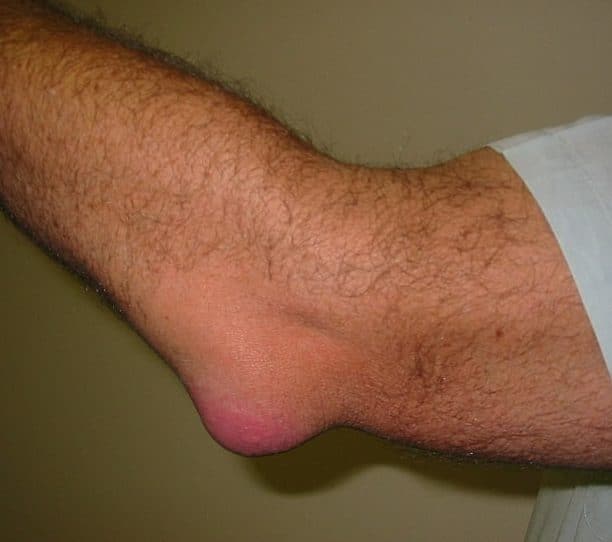Introduction
Olecranon bursitis is a common inflammatory pathology of the elbow. The olecranon bursa is prone to inflammation due to its superficial position and its vulnerability to pressure and trauma.
Most patients develop the condition due to repetitive flexion-extension movements at the elbow, causing irritation of the bursa. Less common non-infective causes include gout and rheumatoid arthritis.
Less commonly, the fluid within the bursa can become infected, through a skin abrasion or puncture (most commonly from S. aureus), leading to a bursitis too.
Clinical Features
Patients present with pain and swelling over the olecranon. The patient may report a small volume of swelling for some time, only with recent increase in size, discomfort, or erythema.
On examination, as the joint capsule is not involved, range of motion is usually preserved, with minimal discomfort unless at the extremes of movement*. The swelling can be large and, if infected, systemic symptoms such as fever or lethargy may be present.
Ensure to examine the contralateral elbow joint, as well as the ipsilateral shoulder and wrist.
*This contrasts with septic arthritis of the elbow in which any movement of the joint will produce large amounts of pain.
Differential Diagnosis
Differential diagnoses for olecranon bursitis are inflammatory arthropathies, gout, cellulitis, and septic arthritis.
Investigations
Routine bloods, including a FBC and CRP, should be taken. Any suggestion of rheumatological causes may warrant further specialised tests. Serum urate levels should be checked if the history is suggestive of gout (or if bilateral disease).
Plain film radiographs of the elbow joint will not confirm the diagnosis, but may aid in ruling out any bony injury.
Definitive diagnosis is from aspiration of the fluid, being sent for microscopy and for culture, which can assess for evidence of infection and for the presence crystals. This also can provide symptomatic relief for some patients.

Figure 2 – A plain film radiograph showing soft tissue swelling (with associated bony spur) from olecranon bursitis
Aspiration of an Olecranon Bursa
This is a sterile procedure usually best performed with the patient sat down and their elbow placed on a surface higher than their shoulder to allow easier access to the olecranon.
The swelling should be palpated, and the aspiration point should lie in the area of greatest fluctuance. The needle should not enter the joint capsule and risk seeding infection.
The aspirated fluid can then be sent for microscopy and culture.
Management
Treatment is dependent on the presence of infection.
Swellings without an infection can be treated with analgesia (ideally NSAIDs) and rest, with splinting of the elbow for a short period of time if required. Occasionally if the swelling is large and causing high levels of discomfort, patients can undergo a washout in theatre (even with the bursa not being infected). Surgical management of bursitis and corticosteroid injection are both associated with increased complications (see below).
If infection is present or the patient has systemic symptoms, then intravenous antibiotics as per local guidelines are indicated, as well as surgical drainage. Prolonged or interactable cases can be treated with either long antibiotic courses or in some cases a bursectomy can provide helpful relief.
Complications
Most cases will resolve spontaneously. Rarely, septic arthritis or osteomyelitis can develop in infective cases, which will likely need surgical intervention.
Key Points
- Olecranon bursitis is inflammation of the olecranon bursa
- Patients present with pain and swelling over the olecranon
- Definitive diagnosis is from aspiration of the fluid, with aetiology either infective or non-infective
- Infective cases warrant intravenous antibiotics and surgical washout, non-infective cases can be treated with rest and analgesia

